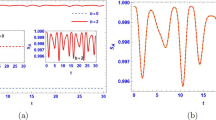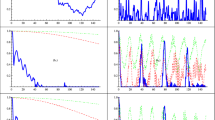Abstract
We study the dynamics of entanglement between two spins which is created by the coupling to a common thermal reservoir. The reservoir is a spin-\(\frac{1}{2}\) Ising transverse field chain thermally excited; the two defect spins couple to two spins of the chain which can be at a macroscopic distance. In the weak-coupling and low-temperature limit, the spin chain is mapped onto a bath of linearly interacting oscillators using the Holstein–Primakoff transformation. We analyze the time evolution of the density matrix of the two defect spins for transient times and deduce the entanglement which is generated by the common reservoir. We discuss several scenarios for different initial states of the two spins and for varying distances.




Similar content being viewed by others
Notes
For chain sizes much larger than the defect spins separation, chains with even or odd number of spins should lead to equivalent dynamics.
As the environment has periodic boundary conditions, the choice of coupling positions is only restrictive in that the number of particles between the defect spins must be even.
References
A. Orieux, E. Diamanti, Recent advances on integrated quantum communications. J. Opt. 18(8), 083002 (2016)
J. Yin, Y. Cao, Y.-H. Li, S.-K. Liao, L. Zhang, J.-G. Ren, W.-Q. Cai, W.-Y. Liu, B. Li, H. Dai, G.-B. Li, L. Qi-Ming, Y.X. Yun-Hong Gong, S.-L. Li, F.-Z. Li, Y.-Y. Yin, Z.-Q. Jiang, M. Li, J.-J. Jia, G. Ren, D. He, Y.-L. Zhou, X.-X. Zhang, N. Wang, X. Chang, Z.-C. Zhu, N.-L. Liu, Y.-A. Chen, L. Chao-Yang, R. Shu, C.-Z. Peng, J.-Y. Wang, J.-W. Pan, Satellite-based entanglement distribution over 1200 kilometers. Science 356(6343), 1140–1144 (2017)
J.-G. Ren, X. Ping, H.-L. Yong, L. Zhang, S.-K. Liao, J. Yin, W.-Y. Liu, W.-Q. Cai, M. Yang, L. Li, K.-X. Yang, X. Han, Y.-Q. Yao, J. Li, W. Hai-Yan, S. Wan, L. Liu, D.-Q. Liu, Y.-W. Kuang, Z.-P. He, P. Shang, C. Guo, R.-H. Zheng, K. Tian, Z.-C. Zhu, N.-L. Liu, L. Chao-Yang, R. Shu, Y.-A. Chen, C.-Z. Peng, J.-Y. Wang, J.-W. Pan, Ground-to-satellite quantum teleportation. Nature 549(7670), 70–73 (2017)
M. Takita, A.W. Cross, A.D. Córcoles, J.M. Chow, J.M. Gambetta, Experimental demonstration of fault-tolerant state preparation with superconducting qubits. Phys. Rev. Lett. 119(18), 180501 (2017)
C. Neill, P. Roushan, K. Kechedzhi, S. Boixo, S.V. Isakov, V. Smelyanskiy, A. Megrant, B. Chiaro, A. Dunsworth, K. Arya, R. Barends, B. Burkett, Y. Chen, Z. Chen, A. Fowler, B. Foxen, M. Giustina, R. Graff, E. Jeffrey, T. Huang, J. Kelly, P. Klimov, E. Lucero, J. Mutus, M. Neeley, C. Quintana, D. Sank, A. Vainsencher, J. Wenner, T.C. White, H. Neven, J.M. Martinis, A blueprint for demonstrating quantum supremacy with superconducting qubits. Science 360(6385), 195–199 (2018)
V. Giovannetti, S. Lloyd, L. Maccone, Advances in quantum metrology. Nat. Photonics 5(4), 222–229 (2011)
A. Einstein, B. Podolsky, N. Rosen, N. Bohr, Can quantum-mechanical description of physical reality be considered complete? Phys. Rev. 47, 696 (1935)
R. Horodecki, M. Horodecki, K. Horodecki, Quantum entanglement. Rev. Mod. Phys. 81(2), 865–942 (2009)
C. Feiler, W.P. Schleich, Entanglement and analytical continuation: an intimate relation told by the Riemann zeta function. New J. Phys. 15(6), 063009 (2013)
W.H. Zurek, Decoherence, einselection, and the quantum origins of the classical. Rev. Mod. Phys. 75(3), 715–775 (2003)
W.P. Schleich, Quantum physics: engineering decoherence. Nature 403(6767), 256–257 (2000)
F. Benatti, R. Floreanini, M. Piani, Environment induced entanglement in Markovian dissipative dynamics. Phys. Rev. Lett. 91(7), 70402 (2003)
A.R.R. Carvalho, M. Busse, O. Brodier, C. Viviescas, A. Buchleitner, Optimal dynamical characterization of entanglement. Phys. Rev. Lett. 98(19), 190501 (2007)
F. Mintert, A. Carvalho, M. Kus, A. Buchleitner, Measures and dynamics of entangled states. Phys. Rep. 415(4), 207–259 (2005)
T. Yu, J. Eberly, Phonon decoherence of quantum entanglement: robust and fragile states. Phys. Rev. B 66(19), 193306 (2002)
L. Hackermüller, K. Hornberger, B. Brezger, A. Zeilinger, M. Arndt, Decoherence of matter waves by thermal emission of radiation. Nature 427(6976), 711–4 (2004)
T. Konrad, F. de Melo, M. Tiersch, C. Kasztelan, A. Aragão, A. Buchleitner, Evolution equation for quantum entanglement. Nat. Phys. 4(4), 99–102 (2007)
M. Tiersch, F. de Melo, A. Buchleitner, Universality in open system entanglement dynamics. J. Phys. A Math. Theor. 46(8), 085301 (2013)
P. Wendenbaum, B.G. Taketani, D. Karevski, Decoherence of Bell states by local interactions with a suddenly quenched spin environment. Phys. Rev. A 90(2), 022125 (2014)
J. Preskill, Fault tolerant quantum computation, in Introduction to Quantum Computation and Information, ed. by H.-K. Lo, T. Spiller, S. Popescu (World Scientific Publishing Co. Pte. Ltd., Singapore, 1998), pp. 213–269. (chapter 8)
P. Facchi, D.A. Lidar, S. Pascazio, Unification of dynamical decoupling and the quantum Zeno effect. Phys. Rev. A 69(3), 032314 (2004)
S. Maniscalco, F. Francica, R.L. Zaffino, N.L. Gullo, F. Plastina, Protecting entanglement via the quantum Zeno effect. Phys. Rev. Lett. 100(9), 90503 (2008)
Y.-S. Kim, J.-C. Lee, O. Kwon, Y.-H. Kim, Protecting entanglement from decoherence using weak measurement and quantum measurement reversal. Nat. Phys. 8(2), 117–120 (2011)
S. Pielawa, G. Morigi, D. Vitali, L. Davidovich, Generation of Einstein–Podolsky–Rosen-entangled radiation through an atomic reservoir. Phys. Rev. Lett. 98(24), 240401 (2007)
S. Diehl, A. Micheli, A. Kantian, B. Kraus, H.P. Büchler, P. Zoller, Quantum states and phases in driven open quantum systems with cold atoms. Nat. Phys. 4, 878–883 (2008)
F. Verstraete, M.M. Wolf, J. Ignacio Cirac, Quantum computation and quantum-state engineering driven by dissipation. Nat. Phys. 5, 633–636 (2009)
S. Pielawa, L. Davidovich, D. Vitali, G. Morigi, Engineering atomic quantum reservoirs for photons. Phys. Rev. A 81(4), 043802 (2010)
H. Krauter, C.A. Muschik, K. Jensen, W. Wasilewski, J.M. Petersen, J. Ignacio Cirac, E.S. Polzik, Entanglement generated by dissipation and steady state entanglement of two macroscopic objects. Phys. Rev. Lett. 107(8), 080503 (2011)
C.A. Muschik, E.S. Polzik, J. Ignacio Cirac, Dissipatively driven entanglement of two macroscopic atomic ensembles. Phys. Rev. A 83(5), 52312 (2011)
J.T. Barreiro, M. Müller, P. Schindler, D. Nigg, T. Monz, M. Chwalla, M. Hennrich, C.F. Roos, P. Zoller, R. Blatt, An open-system quantum simulator with trapped ions. Nature 470(7335), 486–91 (2011)
A. Messinger, B.G. Taketani, F.K. Wilhelm, Left-handed superlattice metamaterials for circuit QED. Phys. Rev. A 99(3), 032325 (2019)
H. Wang, A.P. Zhuravel, S. Indrajeet, B.G. Taketani, M.D. Hutchings, Y. Hao, F. Rouxinol, F.K. Wilhelm, M.D. LaHaye, A.V. Ustinov, B.L.T. Plourde, Mode structure in superconducting metamaterial transmission-line resonators. Phys. Rev. Appl. 11(5), 054062 (2019)
F. Pastawski, L. Clemente, J.I. Cirac, Quantum memories based on engineered dissipation. Phys. Rev. A 83(1), 012304 (2011)
K.G.H. Vollbrecht, C.A. Muschik, J. Ignacio Cirac, Entanglement distillation by dissipation and continuous quantum repeaters. Phys. Rev. Lett. 107(12), 120502 (2011)
G. Goldstein, P. Cappellaro, J.R. Maze, J.S. Hodges, L. Jiang, A.S. Sø rensen, M.D. Lukin, Environment-assisted precision measurement. Phys. Rev. Lett. 106(14), 140502 (2011)
L. Campos Venuti, C. Degli Esposti Boschi, M. Roncaglia, Long-distance entanglement in spin systems. Phys. Rev. Lett. 96(24), 247206 (2006)
L. Campos Venuti, C. Degli Esposti Boschi, M. Roncaglia, Qubit teleportation and transfer across antiferromagnetic spin chains. Phys. Rev. Lett. 99(6), 60401 (2007)
S.M. Giampaolo, F. Illuminati, Long-distance entanglement in many-body atomic and optical systems. New J. Phys. 12(2), 025019 (2010)
D.A. Lidar, K.B. Whaley, Decoherence-free subspaces and subsystems, in Irreversible Quantum Dynamics, vol. 622, ed. by F. Benatti, R. Floreanini (Springer, Berlin, 2003), pp. 83–120
A. Wolf, G. De Chiara, E. Kajari, E. Lutz, G. Morigi, Entangling two distant oscillators with a quantum reservoir. Europhys. Lett. 95(6), 60008 (2011)
E. Kajari, A. Wolf, E. Lutz, G. Morigi, Statistical mechanics of entanglement mediated by a thermal reservoir. Phys. Rev. A 85(4), 42318 (2012)
T. Fogarty, E. Kajari, B.G. Taketani, A. Wolf, T. Busch, G. Morigi, Entangling two defects via a surrounding crystal. Phys. Rev. A 87(5), 050304 (2013)
B.G. Taketani, T. Fogarty, E. Kajari, T. Busch, G. Morigi, Quantum reservoirs with ion chains. Phys. Rev. A 90(1), 012312 (2014)
D. Braun, Creation of entanglement by interaction with a common heat bath. Phys. Rev. Lett. 89(27), 277901 (2002)
L. Campos Venuti, S.M. Giampaolo, F. Illuminati, P. Zanardi, Long-distance entanglement and quantum teleportation in XX spin chains. Phys. Rev. A 76(5), 52328 (2007)
T. Stauber, F. Guinea, F. Guinea, Entanglement of spin chains with general boundaries and of dissipative systems. Ann. Phys. 18(7), 561–584 (2009)
T. Holstein, H. Primakoff, Field dependence of the intrinsic domain magnetization of a ferromagnet. Phys. Rev. 58(12), 1098–1113 (1940)
W.K. Wootters, Entanglement of formation of an arbitrary state of two qubits. Phys. Rev. Lett. 80(10), 2245–2248 (1998)
U. Weiss, Quantum Dissipative Systems, 2nd edn. (World Scientific, Singapore, 1999)
A. Osterloh, L. Amico, G. Falci, R. Fazio, Scaling of entanglement close to a quantum phase transitions. Nature 416, 608 (2002)
F.M. Cucchietti, S. Fernandez-Vidal, J.P. Paz, Universal decoherence induced by an environmental quantum phase transition. Phys. Rev. A 75(3), 032337 (2007)
J.D. Baltrusch, C. Cormick, G. Morigi, Quantum quenches of ion Coulomb crystals across structural instabilities. Phys. Rev. A 86, 032104 (2012)
P. Törmä, I. Jex, W.P. Schleich, Localization and diffusion in Ising-type quantum networks. Phys. Rev. A 65(5), 052110 (2002)
Acknowledgements
The authors are grateful to Alexander Wolf and Thomas Fogarty for helpful discussions and to Wolfgang Schleich for his insightful advice and for inspiring and stimulating discussions. G.M. acknowledges support from DPG SPP 1929. B.G.T. also acknowledges support from FAPESC and CNPq INCT-IQ (465469/2014-0).
Author information
Authors and Affiliations
Corresponding author
A Time evolution of the reduced density matrix
A Time evolution of the reduced density matrix
Under the assumption of vanishing defects free Hamiltonian, the full dynamics is described by
In the interaction picture with respect to the bath Hamiltonian, we find
Using Baker–Campbell–Hausdorff expansion, one easily finds
Neglecting the free defects Hamiltonian permits us to write the full time evolution operator as \({\widetilde{U}}(t)={\widetilde{U}}^S(t){\widetilde{U}}^A(t)\). Operators \({\widetilde{U}}^{(S,A)}(t)\) can now be obtained with the Ansatz
Deriving \({\widetilde{U}}(t)\) with respect to time
where the dot represents time derivative and the explicit time dependence has been omitted. Schrödinger’s equation for the evolution operator \(\dot{{\widetilde{U}}}(t)=-i{\widetilde{H}}^{(I)}(t){\widetilde{U}}(t)\) can be now used to find \(\phi _i^{A(B)}\) and \(\phi _i^{'A(B)}\). Using the initial condition \({\widetilde{U}}(0)=\mathbb {1}\), we find
The evolution operator is seen to be a displacement operator
with
and \({\mathbf {e}}_j\) are unit vectors on the j-th direction.
The evolved reduced density matrix of the defects can now be obtained by assuming a thermal environment and integrating over the bath degrees of freedom. After a lengthy but straightforward calculation, the matrix elements in the eigenbasis \(\{{|s_i\rangle } \}\) of the \(S_x^{S,A}\) operator are given by
where the coefficients \(f^{S,A}(t)\) and \(\varphi ^{S,A}(t)\) are given by
and \({\widetilde{n}}^S_i\) (\({\widetilde{n}}^A_i\)) is the thermal occupation number of mode i of the symmetric (antisymmetric) bath defined by \({\widetilde{n}}^{S,A}_i=\displaystyle (e^{{\widetilde{\omega }}_i^{S,A}/T}-1)^{-1}\).
Rights and permissions
About this article
Cite this article
Wendenbaum, P., Taketani, B.G., Kajari, E. et al. Dynamics of entanglement creation between two spins coupled to a chain. Eur. Phys. J. Plus 135, 182 (2020). https://doi.org/10.1140/epjp/s13360-020-00225-x
Received:
Accepted:
Published:
DOI: https://doi.org/10.1140/epjp/s13360-020-00225-x




